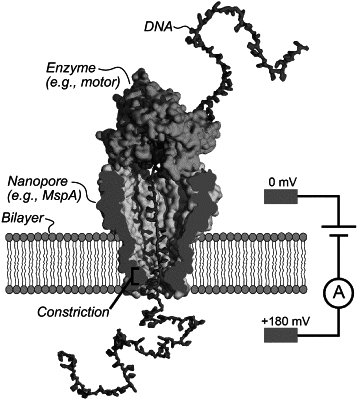| CPC G01N 27/44743 (2013.01) [G01N 27/44791 (2013.01); G01N 33/48721 (2013.01); G01N 33/6818 (2013.01)] | 20 Claims |

|
1. A method of characterizing a protein in a nanopore system comprising a nanopore disposed in a membrane that separates a first conductive liquid medium from a second conductive liquid medium, wherein the nanopore comprises a tunnel that provides liquid communication between the first conductive liquid medium and the second conductive liquid medium, and wherein the protein is physically associated with a hydrocarbon polymer in the first conductive liquid medium, wherein the hydrocarbon polymer comprises a backbone with a carbon chain, the method comprising:
(a) applying an electrical potential between the first conductive liquid medium and the second conductive liquid medium and causing the polymer to interact with the nanopore tunnel, wherein the protein is unable to pass through the nanopore tunnel;
(b) measuring an ion current through the nanopore during the interaction of the polymer with the nanopore tunnel to provide a current pattern;
(c) determining a position and/or movement of at least one polymer subunit in the nanopore tunnel from the current pattern; and
(d) associating the position and/or movement of the at least one polymer subunit with a characteristic of the protein.
|